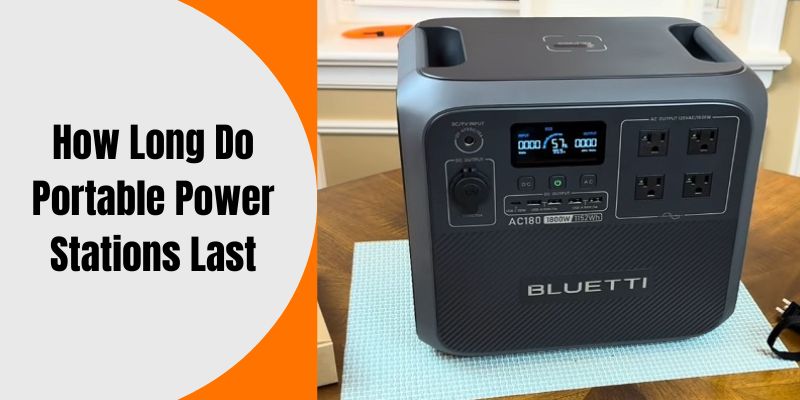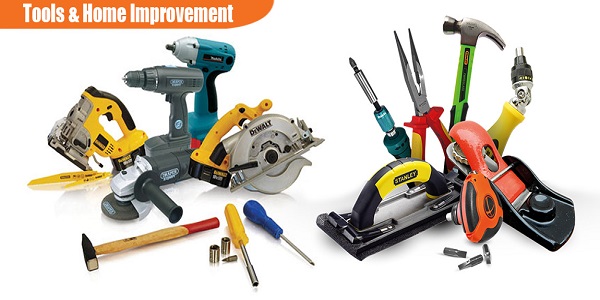Portable power stations typically last between 3 to 10 years. Their lifespan depends on usage, maintenance, and battery quality.
These devices are becoming essential for outdoor adventures and emergency situations. They offer a reliable source of energy when traditional power sources aren’t available. But many wonder about their longevity. Understanding how long these power stations last is crucial for planning trips or preparing for power outages.
Factors like battery type, frequency of use, and charging habits play a big role. Knowing these can help you maximize the life of your portable power station. In this guide, we explore what affects their lifespan and offer tips to ensure your power station remains a dependable companion for years. Stay informed and make the most of your investment.

Lifespan Factors
Understanding the factors that influence the lifespan of portable power stations can help you make informed decisions. These devices, though compact, are packed with technology that can wear down over time. So, what exactly determines how long your portable power station will last?
Battery Type
The type of battery used in your portable power station plays a crucial role in its longevity. Lithium-ion batteries are popular for their lightweight and efficient power storage. However, they generally offer around 500 to 1,000 charge cycles before their capacity starts to decline.
On the other hand, lithium iron phosphate (LiFePO4) batteries can provide up to 2,000 to 3,500 cycles. They’re often heavier but are known for their extended lifespan. Consider what trade-off is more valuable to you: portability or longevity?
Usage Patterns
How you use your portable power station affects its lifespan significantly. Frequent charging and discharging can reduce the number of cycles it can handle. If you often drain your power station to zero, it may wear out quicker.
Maintaining a charge level between 20% and 80% can help extend its life. Do you often leave your power station plugged in even when it’s fully charged? This habit can also shorten the battery’s lifespan.
Think about your usage habits. Could minor adjustments help you get more out of your device? By understanding these factors, you can maximize the lifespan of your portable power station and ensure it remains a reliable companion on your adventures.
Battery Capacity
Battery capacity is a crucial factor in determining the lifespan of portable power stations. It directly influences how long the device can supply power before requiring a recharge. Understanding battery capacity helps users make informed decisions about which portable power station suits their needs.
Watt-hours Explained
Watt-hours measure a battery’s energy storage capability. They show how much power a battery can deliver over time. For example, a 500 watt-hour battery can provide 500 watts for one hour. Or it can deliver 250 watts for two hours. This unit helps compare different batteries easily. Higher watt-hours mean more energy storage.
Impact On Duration
The duration a portable power station lasts depends on its watt-hour capacity. A battery with more watt-hours can run devices longer. This is especially useful for camping or emergency situations. Devices with high power requirements drain the battery faster. So, it’s important to consider the power needs of your devices. This ensures the power station lasts as needed.
Charging Cycles
Portable power stations typically last for several hundred charging cycles. Their lifespan depends on usage and care. Generally, a well-maintained unit can provide reliable service for years.
Imagine you’re camping in the wild, far from the hustle and bustle of city life, relying on your trusty portable power station to keep your gadgets running. But how do you ensure your power station lasts for many adventures? The secret lies in understanding its charging cycles. Charging cycles are the lifeblood of your power station, determining how long it remains efficient and reliable. Let’s delve into what charging cycles mean for your device’s longevity and how they affect your power station’s lifespan.
Cycle Count
The cycle count of a portable power station refers to the number of times it can be charged and discharged before its capacity begins to noticeably degrade. A typical lithium-ion battery, found in most power stations, might boast around 500 to 1000 cycles.
Imagine those cycles as a countdown. Each time you fully charge and then use your power station, one cycle ticks off. If you’re like me, using your power station for weekend trips, that means several years of reliable service. But, if you’re a daily user, those cycles will tick away faster.
Understanding your usage pattern can help you gauge how long your power station will last. Do you rely on it heavily or just occasionally? Knowing this can guide you in making the right choice when purchasing a power station.
Effect On Longevity
The number of charging cycles directly impacts your power station’s longevity. More cycles mean more wear and tear, leading to reduced capacity over time. Think about how your phone battery drains faster after a couple of years; it’s the same principle.
If you want to extend your power station’s life, consider using it wisely. Avoid fully discharging it every time; partial charges can help preserve those precious cycles. Also, consider storing it properly when not in use. Extreme temperatures can speed up degradation.
Have you ever wondered if investing in a higher cycle count model is worth it? While it might cost more upfront, it could save you money in the long run, reducing the need for frequent replacements. Consider the balance between cost and durability for your unique needs.
Ultimately, understanding charging cycles is crucial in maximizing your portable power station’s lifespan. Are you using yours to its fullest potential, or are there adjustments you could make for a better experience?

Environmental Influences
Portable power stations are a lifesaver when you’re off the grid or facing power outages. However, their longevity is influenced by various environmental factors. Understanding these can help you make the most of your device and plan effectively.
Temperature Effects
Temperature can drastically affect the performance of your power station. Cold weather can reduce battery efficiency, leading to shorter power duration. On a camping trip in the mountains, I noticed my power station lasting far less than expected. To counter this, keep your device warm or insulated.
Conversely, high temperatures can cause overheating and degrade battery health. Is your power station frequently exposed to direct sunlight? Shade it or store it in a cooler environment to enhance its lifespan.
Humidity Concerns
Humidity can also have a significant impact. Excess moisture can corrode internal components, reducing efficiency over time. While boating, I placed my power station in a waterproof bag, protecting it from the humid environment.
On the flip side, dry conditions can lead to static buildup, which might harm sensitive electronics. Is your area prone to dry air? Consider using moisture absorbers or storing your power station in a slightly humidified space.
Have you considered how environmental influences might be affecting your portable power station? By taking a few simple precautions, you can extend its longevity and reliability.
Brand Variations
When choosing a portable power station, brand variations play a crucial role. Different brands offer varied features, quality, and lifespan. Understanding these differences can help buyers make informed decisions.
Quality Differences
Portable power stations vary in quality. Some brands use higher-grade materials. This affects the durability and performance. Better materials often mean longer lifespan. Lesser-known brands might cut corners. This could lead to quicker wear and tear.
Reputable brands invest in research. They focus on improving battery technology. Higher quality batteries last longer. They provide consistent power output. Consider these factors when choosing a brand.
Warranty Considerations
Warranty is a vital aspect of brand choice. Top brands usually offer longer warranties. This reflects their confidence in product durability. Longer warranties provide peace of mind. They cover potential defects and repairs.
Some brands have shorter warranty periods. This might indicate lower reliability. Check the warranty terms carefully. Some may cover only specific parts. Understanding warranty coverage helps avoid unexpected costs.

Maintenance Tips
Portable power stations typically last between 3 to 5 years with proper care. Regular cleaning and avoiding overcharging extend their lifespan. Store them in a cool, dry place to prevent damage.
Maintaining your portable power station can significantly impact how long it lasts and how well it performs. Proper care ensures that you’re never left in the dark, whether you’re camping in the wilderness or facing a sudden power outage at home. Let’s dive into some maintenance tips that will help you get the most out of your investment.
Regular Charging
Keeping your portable power station charged is crucial. If you leave it unused for long periods, its battery can degrade. Make it a habit to charge it every few months, even if you haven’t used it.
When I first bought my power station, I forgot about it for nearly a year. When I finally needed it, the battery was nearly dead. Regular charging can prevent this surprise.
Consider setting a reminder on your phone to charge your power station. This simple step can save you from the frustration of a dead battery when you need it most.
Proper Storage
Proper storage of your power station can also extend its lifespan. Store it in a cool, dry place away from direct sunlight and extreme temperatures. These conditions can damage the battery and reduce its effectiveness over time.
A friend of mine stored his power station in a hot garage, thinking it would be fine. When he needed it, the battery’s performance had significantly dropped. Don’t let this happen to you.
Also, keep the power station off the ground to prevent moisture damage. Use a shelf or a dedicated space in a closet to ensure it stays safe and ready for use.
Are you taking these steps to maintain your portable power station? Small efforts in maintenance can ensure that your power station remains a reliable companion for years to come.
Technological Advances
Technological advances have greatly improved portable power stations. These changes enhance both performance and lifespan. New features make them more reliable and efficient. Let’s explore how these innovations impact their longevity.
Battery Innovation
Battery technology has seen significant progress. Lithium-ion batteries now power most portable stations. They are lighter and store more energy. This means longer usage between charges. Some models use lithium iron phosphate. This type offers even more cycles. It lasts longer than traditional options. Improved battery management systems also play a role. They ensure optimal charging and discharging. This extends the battery’s life significantly.
Smart Features
Smart features make power stations more user-friendly. Many come with smart displays. These provide real-time data on power usage. You can see how much battery is left. This helps in planning your usage better. Some units have Bluetooth connectivity. You can control them with your phone. These features help in efficient energy management. They also prevent unnecessary power drain. Smart technology means your station lasts longer. It ensures you use energy wisely.

User Reviews
Portable power stations generally last between 3 to 5 years, depending on usage and maintenance. Batteries may degrade faster with frequent usage or improper care. User reviews often highlight lifespan differences based on brand and model quality.
Portable power stations have become popular among travelers and campers. They offer convenience during outdoor adventures. But how well do they perform according to users? Real-world experiences can provide valuable insights. User reviews highlight both the strengths and weaknesses of these devices. Let’s explore what customers have to say.
Common Complaints
Some users mention issues with battery lifespan. They expect longer durations between charges. Another frequent concern is the weight of some models. Heavier units can be a burden during travel. Occasionally, users report difficulty with setup. Instructions are sometimes unclear or too technical. Noise levels also receive criticism. Some power stations are louder than expected. These complaints help potential buyers make informed choices.
Positive Feedback
Many users praise the portability of power stations. Their compact size makes them easy to carry. Customers appreciate the quick charging feature. It reduces downtime significantly. Another favorite is the versatility of these devices. They power various gadgets efficiently. Users also commend the durability. Power stations withstand harsh outdoor conditions. Positive reviews often highlight customer service. Prompt responses make users feel valued.
Frequently Asked Questions
How Many Hours Will A Portable Power Station Last?
A portable power station’s duration depends on its capacity and the device’s power usage. Typically, it lasts 5 to 20 hours. Check the power station’s watt-hour (Wh) rating and calculate based on your device’s wattage to estimate duration. Higher capacity models provide longer usage times.
What Is The Life Expectancy Of A Portable Power Station?
Portable power stations typically last 5 to 10 years, depending on usage and maintenance. Battery cycles influence lifespan. Proper care, such as avoiding extreme temperatures and regular charging, can extend life expectancy. Regularly checking and following manufacturer guidelines also helps maintain optimal performance and longevity.
Is It Worth Buying A Portable Power Station?
Yes, a portable power station is worth buying for outdoor activities and emergencies. It offers convenient, reliable power. These stations are compact, eco-friendly, and versatile, charging multiple devices. Investing in one ensures you’re prepared for power outages or remote adventures.
How Long Will A Portable Power Station Run A Tv?
A portable power station can run a TV for 2-10 hours. Battery capacity and TV wattage affect duration. Calculate runtime by dividing power station watt-hours by TV watts. Always check your specific devices for accurate estimates. Consider energy-efficient TVs to extend usage time.
Final Thoughts
Portable power stations offer great convenience. Their lifespan varies with use and care. On average, they last several years. Regular maintenance can extend their life. Keep them clean and charge them properly. Store them in a cool, dry place. This prevents battery damage.
Consider your power needs before buying. Choose a reliable brand for longer durability. Read reviews and check warranties. This helps you make an informed decision. With proper care, your power station will serve you well. A reliable companion for your adventures and power needs.


